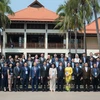Hanoi (VNA) – With its recent increase in adoption rate, innovations in artificial intelligence (AI) technology are looking to have a big impact on the workforce across the Association of Southeast Asian Nations (ASEAN) over the next few decades, according to a new study by Cisco and Oxford Economics.
Titled “Technology and the Future of ASEAN Jobs”, the study highlights that innovations in digital technology will present big opportunities to ASEAN economies to boost their productivity and prosperity. The more widespread adoption of existing technologies, coupled with advances in the use of AI through software, hardware, and robotics, will help bring down costs of goods and services, driving up demand and creating millions of new jobs.
The study, which publicised by Cisco on September 12 within the framework of the World Economic Forum on ASEAN (WEF ASEAN) 2018, predicts that the sectors that will see the greatest rise in demand for new workers are wholesale and retail (1.8 million new jobs), manufacturing (0.9 million), construction (0.9 million), and transport (0.7 million).
However, there will be a marked shift in the region’s labour market as lower-skilled jobs are displaced. According to the study, given the productivity gains from the adoption of AI-enabled technologies, ASEAN’s six largest economies will require 28 million fewer workers by 2028 – more than 10 percent of the current workforce – to achieve the same level of output as today.
Lower-skilled workers in the service and agriculture sectors will be the most susceptible to displacement, especially as new developments – for example, in global positioning systems, telematics, and smart sensors – are deployed to greater effect.
From a national perspective, jobs restructured vis-à-vis total workforce will be particularly high in the most technologically advanced economies. Singapore could see the biggest relative impact, with up to 21 percent of its workforce being affected. The country’s strong environment for cutting edge digital transformation allows businesses to take advantage of new innovations as they become available. Vietnam and Thailand are next in line, with 14 percent and 12 percent of jobs replaced, respectively. In these countries, a lot of less productive, more monotonous jobs are projected to be eliminated, leaving Vietnamese and Thai workers free to pursue jobs in more fulfilling and productive sectors.
Despite the equally large numbers of jobs displaced in Indonesia, Malaysia, and the Philippines, the impact there will be smaller as a relative share of the total workforce. The structure of the labour markets in those countries, coupled with the abundance of affordable labour, may also make the widespread adoption of AI technology uneconomic for some time to come.
The study predicts that, over a 10-year period, the competing effects of job displacement and creation will offset each other. However, many of these new jobs are likely to be created in areas that are different from those where they are being displaced. As such, as many as 6.6 million workers across the bloc’s six largest economies will have to adapt their skills and forge a new career path to remain productively employed in this evolving labour market.
The study reveals that 41 percent of those in displaced jobs are “acutely lacking” the IT skills that new jobs will be demanding. Almost 30 percent lack “interactive skills” that will be needed for future job openings, such as negotiation, persuasion, and customer service skills. Just over 25 percent also lack “foundational skills”, like active learning, reading, and writing skills crucial for the growth of ASEAN’s labour market.
Naveen Menon, President for Southeast Asia at Cisco, said “ASEAN has done incredibly well in the last 10 years. The availability of a large workforce, coupled with businesses and consumers pushing the boundaries in adopting new technologies, has turned the region into one of the world’s fastest growing economic blocs. As economies look to sustain this growth and evolve to cater for new competencies, it is crucial to ensure that the region’s workforce is not left behind.”
“This will require all stakeholders – businesses, governments, and educators – to work together to ensure the region’s current and future workforce are picking up skills that go beyond just technical knowledge. They need skills like problem solving, design and critical thinking, leadership, collaboration, conflict resolution, and empathy. In the digital future, where everyone will have access to the same data and information, these skills will be the key differentiator between being employable or not,” he added.
The report suggests a range of training approaches, including greater commitment to on-the-job training, more flexible online courses, and work experience schemes to complement or even, in some cases, substitute for a formal school and tertiary education in some cases, to ensure the region’s workforce can acquire the skills needed over the next decades.–VNA























